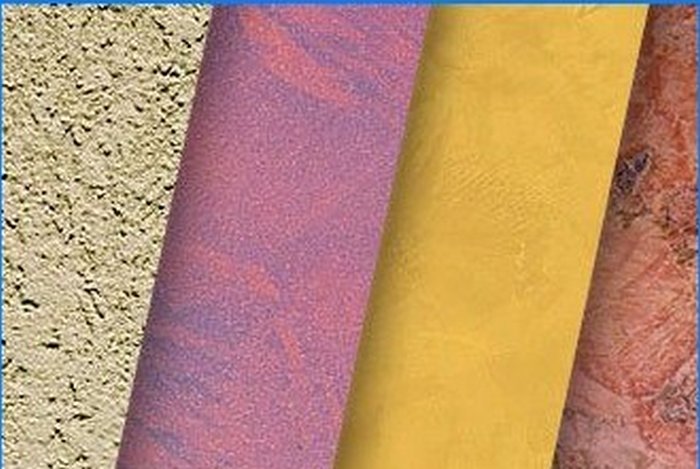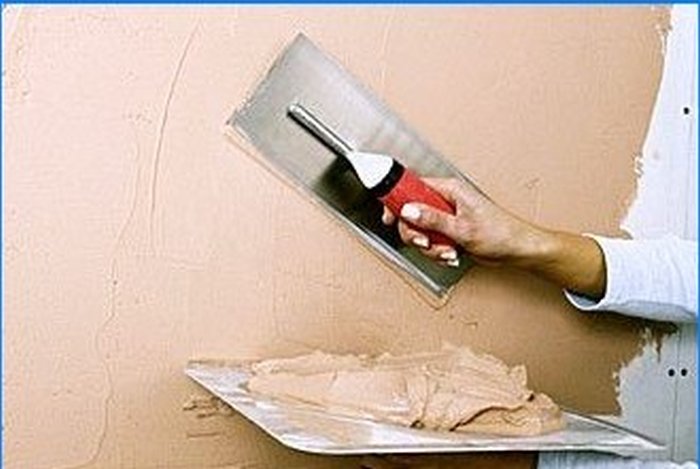The use of facade plaster allows you to level the surface of the walls, repair cracks and potholes, insulate and protect the facade of the building and, of course, decorate it in accordance with your tastes and design ideas. Based on its purpose, facade plaster is divided into two types: repairand decorative.
The first type of plaster serves as a leveling layer and a base for applying decorative plaster. Accordingly, decorative plaster is, in fact, a finish, forming a protective layer and giving the home color and personality..

The choice of facade plasters today is quite large. In order to determine the best option for facade finishing, one should imagine the main parameters of the materials that are used for facade plastering. So, according to their composition, modern mixtures for facade plaster are divided into several types.
- Facade mineral plaster– Perhaps the most common type of plaster used for external finishing work. It is usually made from a cement-sand mortar with various additives and fillers. Such facade plaster is relatively inexpensive, easy to apply and has a high vapor permeability. In addition, mineral plasters do an excellent job of insulating the facade. However, a significant disadvantage of this type of facade plaster is its fragility. After 10 years, you will have to think about refurbishing the facade, as its finishing will require renovation. The fact is that mineral plaster does not have sufficient elasticity, and as a result of building shrinkage and mechanical stress, both microcracks and more serious defects can appear on it. Typically, mineral plaster is a dry mix of white or gray color. A layer of such plaster can be painted, but it is not intended for tinting..

- Acrylic facade plastersmore durable – finishing made with such plaster will not require repairs within 15-25 years. A significant advantage of acrylic facade plaster is its elasticity. However, acrylic plaster does not have sufficient vapor permeability, therefore it is not recommended to use it for facades of buildings, the insulation layer of which consists of basalt wool. Acrylic plaster will be more appropriate when paired with foam. You should also be aware that acrylic facade plaster can lose its original appearance due to dust. Therefore, it is better to refrain from using it if the building is located near roads..
- No less durable silicate facade plaster– its service life is 20-25 years. Such plaster is vapor-permeable, sufficiently elastic, and, in addition, it has an antistatic effect, which means it repels dust and retains its original appearance longer..
- Silicone facade plaster– one of the most relevant types of plaster today. Its parameters of vapor permeability, elasticity and antistaticity are at a high level, which is a condition for a fairly long service life – up to 25 years. Separately, it should be mentioned that silicone plaster does not absorb salts and harmful chemical compounds..
After leveling the facade, a decorative layer is applied using repair plaster. Decorative facade plaster is one of the cheapest and most popular finishing materials. Besides the price, this type of finish has many other advantages. Based on the composition, decorative plaster can be of various types: mineral, synthetic or silicate. Water-based decorative plasters are perfect for interior decorating, but solvent-based plasters are ideal for building facades. Decorative plasters are characterized by extremely high plasticity – they are obedient to any instrument. Thanks to this property, structural or textured plasters allow you to decorate facades and internal walls in a special, unique style..
Structural plasters are a heterogeneous mass with various additives: small pebbles, pieces of mica or quartz, wood fibers, shells and even dry plants. Decorative plaster can imitate various textures. So, for example, “Venetian” plaster, made of marble flour, allows you to create the effect of marble on the treated surface. In the matter of choosing textured plaster, you can generally give free rein to imagination: marble surfaces, imitation wood, walls “antique” … You can decorate the building in any style and in accordance with any tastes.

However, before choosing one or another facade plaster, you should evaluate its characteristics. The parameters of the material determine how suitable it is for your home, as well as its durability and performance.
- In order for the decoration, and accordingly the whole house, to retain its original appearance for a long time, the facade plaster must be resistant to both atmospheric and mechanical influences. It is the layer of facade plaster that is directly susceptible to precipitation, aggressive action of sunlight, pollution, mechanical damage. Therefore, the material from which the facade plaster is made must have mechanical resistance..
- Having increased moisture resistance, the facade coating must at the same time have good vapor permeability. Otherwise, the moisture accumulated during the winter period in the thermal insulation layer will not be able to evaporate, which will cause the destruction of the building facade..
- Facade plaster, used in most of our country, must also have high frost resistance and moisture resistance.
- Facade plaster must have sufficient adhesion (ability to adhere to the treated surface).
- Finally, it is highly desirable that the façade plaster be fire resistant. Traditionally, mineral plasters have the highest fire resistance, but modern manufacturers also produce non-combustible organic-based plasters..
In today’s building materials market, there is a huge selection of facade plasters of the most varied quality, appearance and price category. Facade plasters can be supplied both in the form of dry building mixtures and in the form of ready-made compositions. Modern facade plasters are of high quality and decorative properties, they have many characteristics that allow us to consider them as a full-fledged protection of your home not only from adverse weather conditions, but also from radiation, as well as sound and heat insulation. As you can see, the use of facade plaster has a lot of advantages, it remains only to choose.
Natalia Vilyuma

How long does facade plaster typically last before it needs to be replaced or repaired?